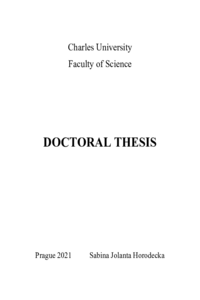Oriented copolymers with liquid crystalline building blocks
Orientované kopolymery obsahující kapalně krystalické stavební bloky
dissertation thesis (DEFENDED)

View/
Permanent link
http://hdl.handle.net/20.500.11956/124811Identifiers
Study Information System: 182424
Collections
- Kvalifikační práce [20084]
Author
Advisor
Referee
Uchman, Mariusz Marcin
Sedláková, Zdeňka
Faculty / Institute
Faculty of Science
Discipline
Macromolecular Chemistry
Department
Department of Physical and Macromolecular Chemistry
Date of defense
16. 2. 2021
Publisher
Univerzita Karlova, Přírodovědecká fakultaLanguage
English
Grade
Pass
Keywords (Czech)
kapalné krystaly, kopolymeryKeywords (English)
liquid crystals, copolymersShrnutí Bylo syntetizováno a studováno několik sérií reverzibilních fyzikálních sítí založených na polydimetylsiloxanových (PDMS) řetězcích a kapalně krystalických (LC) strukturních jednotkách. Materiály patřily do tří různých typů architektury: (1) PDMS s 'naroubovanými' bočními skupinami LC (čtveřice LC v každé pozici naroubování), (2) PDMS ukončený na obou koncích makromolekul jednotkami LC, (3) a lineární 'nekonečné' kopolymery LC-PDMS s pravidelně se střídajícími jednotkami LC a řetězci PDMS. V rámci syntéz byly testovány řetězce PDMS o různých délkách a 6 různých polyaromatických mezogenů se skupinami azo i bez nich. K syntéze všech studovaných materiálů byla použita hydrosilylační reakce mezi mezogeny s vinylovými funkčními skupinami (získaných v rámci mezinárodní spolupráce) a komerčními Si-H-funkčními polydimetylsiloxany. Kopolymery byly fyzikálně sesíťovány nano-agregací jednotek LC obsažených v jejich makromolekulách. Termotropní vlastnosti nano-agregátů LC propůjčily celému materiálu zajímavé fyzikální vlastnosti, díky nimž jsou některé z kopolymerů atraktivní coby potenciální 'inteligentní' materiály. Řetězce PDMS byly vybrány coby stavební jednotky z důvodu jejich extrémní flexibility, která měla propůjčit elastické vlastnosti fyzikálně sesíťovaným kopolymerům. Dalším důvodem byla také...
Several series of reversible physical networks based on polydimethylsiloxane (PDMS) chains and liquid crystalline (LC) structural units were synthesized and studied, which belong to three different architecture types: (1) LC-grafted PDMS (with LC quartets at the grafting sites), (2) LC-end-capped linear PDMS, (3) and linear 'infinite' LC-PDMS copolymers (with alternating LC and PDMS segments). PDMS spacers of different lengths of were tested, as well as 6 different polyaromatic mesogens of azo type and azo-free type. Hydrosilylation coupling of vinyl-functional mesogens, obtained as part of an international cooperation, with commercial Si-H-functional PDMS was employed to synthesize all the studied materials. The copolymers were physically crosslinked by the nano-aggregation of the LC units contained in their macromolecules. The thermotropic properties of the LC-nano-aggregates lent interesting physical properties to the whole material, making some of the copolymers attractive as potential smart materials. The PDMS spacer segments were selected for the sake of their extreme flexibility, which should provide elastic properties to the physically crosslinked copolymers, and also because of their (desired) incompatibility with the mesogens. This latter effect was highly helpful for achieving the...
